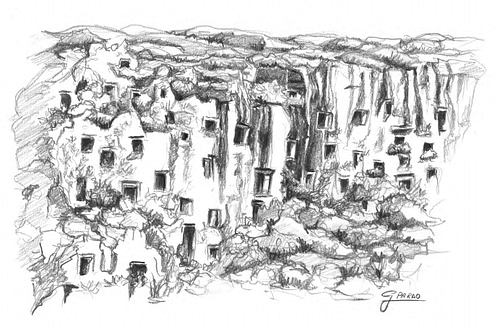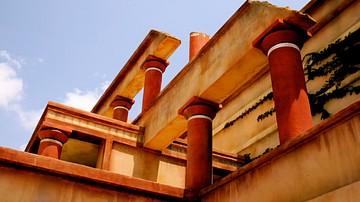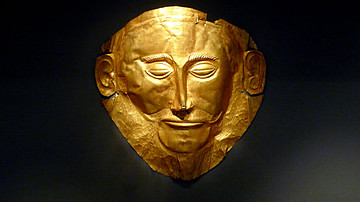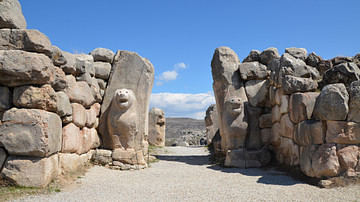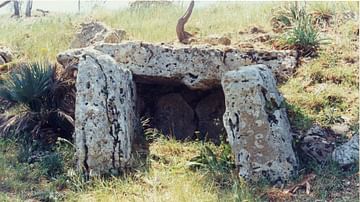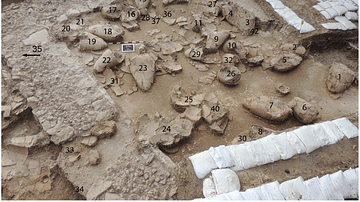The Bronze Age in Sicily, considered one of the most important periods of the island's prehistory, witnessed the establishment of a unitary and in some ways artistically vibrant culture. The three main phases of the period take their name from the most important centres at the time in question: Castelluccio (Early Bronze Age), Thapsos (Middle Bronze Age) and Pantalica (Late Bronze Age). There was a marked increase in cultural and commercial trade between regions near and far, particularly with Cornwall, across the Atlantic coasts of France, Spain, Sardinia, the Tyrrhenian coast to the Strait of Messina, and from here to the Aegean-Anatolian area. It was a world, therefore, in great turmoil, that felt the need to interconnect to achieve a better future.
European Characteristics
Around the end of the 3rd millennium BCE, Europe was involved in a series of technological and social events which developed in metallurgy and in the birth of hierarchical societies. The usage of bronze (2300-1750 BCE), a resistant metal alloy which is easily malleable, permitted the manufacture of a wide range of metal tools such as razors, axes, and blades, that provided for improved living standards of tribes (consisting of 20-30 people) which, in turn, contributed to population growth. These bronze items brought the dawn of mobile and unalterable wealth. Examination of the organization of the tomb areas found in the European necropoles of this era shows that societies began to evolve different classes within them. For instance, singular tombs were used for eminent figures whilst small groups of monumental tombs were employed as the eternal home of important families.
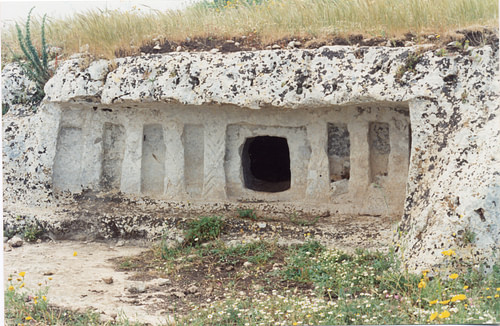
During the Middle Bronze Age (1700-1350 BCE) human settlements became more and more permanent and populous, and the communities settled on a territory, dedicating themselves to the manufacture and distribution of metal artifacts. The most common form of dwelling was the hut - circular or oval in shape. Agricultural practices were greatly developed, including the introduction of the simple plough (asymmetrical ploughshare). Animal husbandry was no longer solely for meat production, but also for animal products, such as milk and wool. The dead continued to be buried in graves or inside caves where combustion traces and animal bones have been found indicating the practice of funeral rites.
The Recent Bronze Age (1320-1170 BCE) witnessed the strengthening of villages following a precise and deliberate security planning, such as the digging of ditches and erection of embankment fortifications. Metalworking took on continental dimensions, uniting the two shores of Europe: the shapes of metal objects of this period, in fact, are very similar both in the south and the north of the continent and highlight the wide circulation of products and models. This was the period in which economies were being standardised, thanks to the intense circulation of people, things and ideas.
The Final Bronze Age (1170-770 BCE) saw the transition from tribal societies to aristocratic societies, the increase in large bronze hoards and craft developments aimed at producing goods for an evermore emerging aristocracy. In much of Europe, the Urnfield culture developed, a phenomenon so extensive that one is led to think that this was an age of migrations. Common practices included funeral rites which provided for the cremation of corpses and the deposition of the ashes in urns buried in extensive fields, together with small ceramic vessels, such as bowls and cups, which probably contained food offerings.
Early Bronze Age Sicily
In Sicily the oldest phases of prehistory were overcome at the end of the 3rd millennium BCE, when it received a new cultural wave, probably from the Middle East, today labelled with the name of the Castelluccio culture, from the homonymous prehistoric site near the city of Noto. This cultural facies (segmentation), rather unusual compared to those of the Copper Age, is verified in the south-east and south of the island, up to the provinces of Agrigento and Caltanissetta (in the west and in the middle of the island), and constitutes the “starting line” of the Sicilian bronze age. It is certainly dated to 2169±120 BCE (calibrated value) thanks to radiometric dating performed on 18 coal samples which proved to be the oldest of this culture and which were found at the archaeological site of "Muculufa", a few kilometres north-east of Licata town.
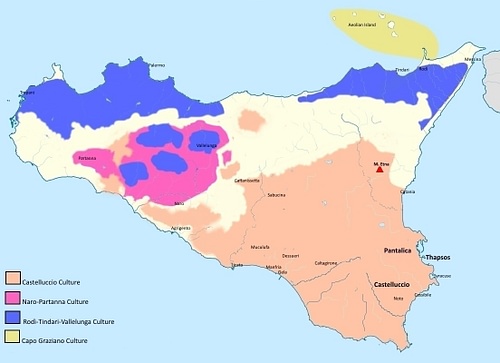
At this early stage of the Bronze Age, Sicily was divided into four macro-regions, each one of them with their own culture: northern Sicily with the Rodì-Tindari-Vallelunga culture, the western one, with the Naro/Partanna culture, the south-east with the Castelluccio culture and the Capo Graziano culture of the Aeolian Islands. Of these, that of Castelluccio seems to be the most homogeneous culture in this period, perhaps because it spread over a larger area and, consequently, it is much better known today.
The prehistoric settlement of Castelluccio was built on a rather isolated but defensible rocky spur. The archaeologist Paolo Orsi, who identified it between the late-19th and early-20th century CE, found large quantities of ceramic fragments among the refuse and explored the artificial cave tombs. These tombs are oven-shaped and dug into the rocks. There are small oval-shaped rooms with a diameter of between 1.5-2.0 metres, sometimes preceded by an ante-cella and still containing grave goods. The Castelluccian villages, sometimes fortified, showed a rather interesting agricultural and pastoral reality. Their ceramics have been classified as "matt-painted ware" and have close ties with an Anatolian culture of the end of the 3rd millennium BCE, so-called "Cappadocia". The wares show a variety of pottery shapes and geometric designs, the latter consisting of brown or black bands crossed on a yellow or red background. Forms include single or two-handled conical glasses, tall footed-vases known as "fruit bowls", large amphorae, bowls on a tall conical foot, and globular pyxides (boxes) on a small conical foot.
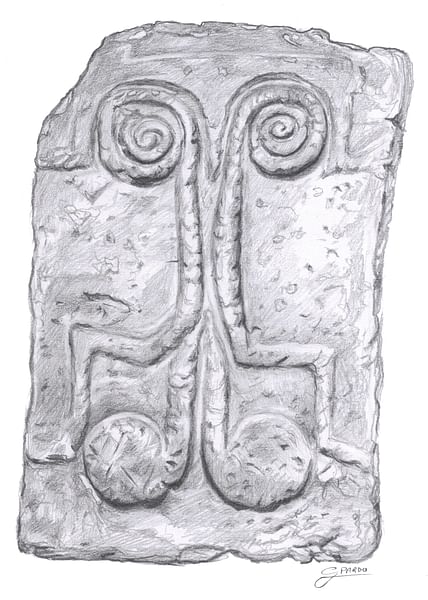
The graves dug in the rock were closed with dry-stone walls, but also with tombstone doors, some decorated in relief with spiral-shaped motifs. In two of the graves there are carved images that could allude to sex, therefore, to the continuation of life. In some of these graves carved globule bones have been found that are reminiscent of examples elsewhere (southeastern Italy, Malta, southern Greece and Troy II and III). The carved bones are animal bone segments and are between 13-15 centimetres in length. They are sometimes decorated with incisions on which, successively, globules in relief have been made. Their use is not yet known, although some scholars have supposed that these artefacts could be small idols, while others think they could be dagger handles.
No doubt the Castelluccio Civilization had dealings with Malta, given that in Manfria, a district of the city of Gela (in south-eastern Sicily), a tomb there contained ceramic fragments in the Maltese "Tarxien Cemetery" style.
Middle Bronze Age
From the end of 1500 to c. 1200 BCE in Sicily, important coastal settlements developed and the island began to acquire strategic-commercial importance thanks to the intense exchanges with Mycenaean Greece. The find of a large number of Aegean vases in the Sicilian tombs of this period proves a phenomenon that caused the birth of real emporia in which the transmarine trades were practised, as had happened in the Aeolian islands. This was just the age that the Milazzese culture flourished in the Aeolian Islands. In Sicily, for its part, a culture closely related to the Aeolian arose, called Thapsos, from the ancient name the Greeks gave to a peninsula (nowadays Magnisi) situated between Augusta and Syracuse, which gives its name to the most famous Sicilian culture of the middle Bronze Age.
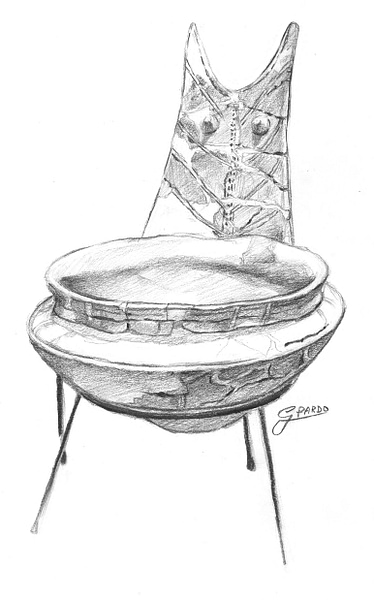
The first archaeological excavations carried out in this little peninsula, about 2 km long and 700 m wide, were made around the end of the 19th century CE, and about 300 artificial cave tombs were identified, some of them Tholos tombs, with frontal entrances or through wells that open on the rocky floor. They are located in several points of the peninsula where, in the central area, another necropolis of enchytrismòs (vase-burials) has been identified, with corpses placed into large earthenware jars inserted in small natural cavities in the ground.
- The prehistoric village was located near the isthmus, and has three phases with three different dwelling types: the first phase (15th-14th century BCE) consisting of circular, oval and horseshoe-shaped huts, without a clear urban planning, except some such huts connected by a real street network in the northern part.
- The second phase (13th-12th century BCE), consisting of several rectangular rooms constituting the residential complexes, arranged in a square configuration around a central paved court, which remind a Mycenaean-type urban planning.
- The third phase (11th-9th century BCE) is characterised by a series of quadrangular environments that have no relation with the previous "backyard" buildings.
The peninsula has returned a rich quantity of ceramic material ranging from the 15th to the 9th century BCE, imported or locally produced, such as three-handled small jars, alabastra, small cups and Mycenaean small pitchers; Cypriot Base Ring II jugs and White Shaved Ware juglets; and Maltese ceramics related to the first phase of the Borġ in-Nadur culture and Bahrija style.
The local pottery consists of high-footed basins decorated with geometric patterns and cups with "sigma" incisions on the upper edge of the vase with representations of birds and fawns on the body. This was when the Mycenaean sailors sailed up and down the Mediterranean, inspiring the tales then later narrated in Homer's Odyssey and inciting the Greeks, centuries later, to seize Sicily.
Late Bronze Age
In the 13th century BCE everything suddenly changed. This period would seem to have been ruled by fear: the ancient coastal settlements were moved to higher sites, difficult to access but easily defendable, such as Pantalica, Montagna di Caltagirone, Dessueri, Sabucina and, later, Cassibile (all areas between south-eastern and central Sicily). While in the Aeolian Islands the Ausoni flourished, a civilization which came from the Italian peninsula, in Sicily a civilization strongly influenced by the Mycenaean one still persisted.
The historical sources (Hellanicus of Mytilene, Fylistus of Syracuse) assert this was the Sicels' time for Sicily, who also came from the Italian peninsula between the 13th and 12th century BCE. However, the archaeological layers following the Thapsos age do not confirm the presence of an Italic civilization. On the contrary, dating to this period is a monumental building made up of several rectangular rooms, the so-called Anaktoron or prince' palace. Built with megalithic techniques using gigantic stone blocks, it is a smaller imitation of the Mycenaean palaces. It also lacks the cremation of the deceased, which, in contrast, was widespread in the Italian peninsula of that era. The ritual will remain unknown in Sicily for a few more centuries yet. The Sicels, therefore, landed a few centuries later in eastern Sicily and drove away the Sicanians to the western part of the island, the dominant population who had lived on most of the island since time immemorial.
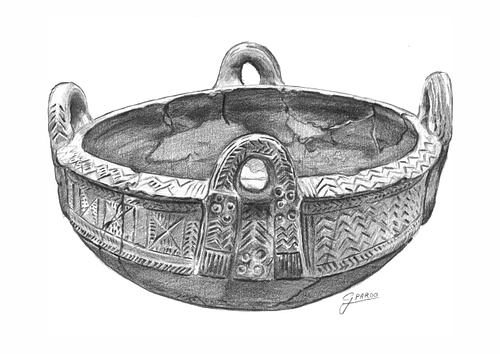
Due to the great confusion of peoples, scholars divide this period into four distinct phases, named after the most characteristic site of this age, Pantalica (a plateau a few kilometres northwest of Syracuse, surrounded by canyons and including five large necropolis with "artificial cave tombs").
Pantalica North
The first phase (13th-11th century BCE), called Pantalica North, is characterized by the Anaktoron that has already been mentioned about and by a pottery shaped on the lathe (a tool used for the first time in Sicily), red and shiny, on high tubular feet similar to those of Thapsos. The personal items and jewellery (blades, pocket knives, swords, necklaces, rings) seem to have a clear Mycenaean influence and denote a large circulation of bronze material. The most characteristic object of this age is the fibula, i.e. a pin for fastening garments, in the simple or violin arch shape.
Cassibile
In the second phase of Pantalica (11th - first half 9th century BCE), named Cassibile from the village near Syracuse where typical tombs of this age are dominant (rounded or rectangular rooms, arranged around a common entrance), there is a replacement of the red pottery by another type painted with feather patterns, similar to those of the Aeolian islands. For its part, the fibula took the shape of an elbow bent bow known as the fibula of Cassibile, after the name of a Syracuse hamlet. That kind of fibula was also present in 11th century BCE Palestine, and the Sicilian bronze objects of this period (fibulae, axes, razors) are very similar to those of Spain and the Atlantic coasts of France and England. A significant phenomenon of this phase is the reoccupation of coastal sites, which encouraged the resumption of maritime trade.
Pantalica South
During the third phase or Pantalica South (second half 9th century BCE - second half 8th century BCE), peoples moved back once again to the Pantalica massif, according to the artificial cave tombs which are numerous, especially in the southern flanks of the hill. Pottery wares appeared imitating Greek decorations, such as the trilobed oinochoai for instance, painted with Aegean geometric designs, while the "feathered painting" was still used in combination with a "parallel furrows" decoration. Discoveries of rings, buttons and spirals are very frequent.
Finocchito
The last phase (second half 8th century BCE - second half 7th century BCE), the fourth, namely Finocchito, a hilly site a few kilometres southwest of the town of Avola, saw the foundation of Greek colonies in large parts of the island which were significantly affected by their culture. The natives now imitated Greek handicraft products both in form and in decoration, producing a rather beautiful ceramics, decorated with Aegean late-geometric motifs. The previous ages fibula also assumed a typically Greek shape, small lozenge and arch-shaped; furthermore, jewellery was produced made of simple or double knitted chains with different shaped pendants. This is the time when iron made its appearance, with which were made knives, spear cusps and especially fibulae. In the Sicilian tombs, now single-celled (that could suggest the birth of private land ownership), there are Greek manufactured objects (proto-Corinthian vases or ivory fibulae) identical to those found in Greek archaic Syracuse tombs.
With the conquest of Sicily by the Greeks (late 8th century BCE), the island not only came out of Prehistory but it was also the end of the previous civilizations. Even that of the Sicels, who were subdued and blended together with the Greeks, until finally disappearing from history in the 4th century BCE.
